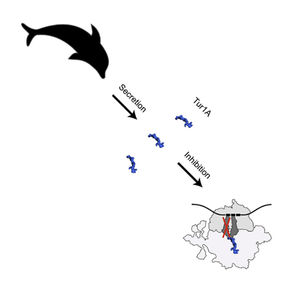

Protecting against bacterial invaders
Antimicrobial peptides
Antimicrobial peptides (AMPs) are small, naturally occurring polypeptides found in all forms of life, where they serve as powerful defense molecules — either by suppressing microbial competitors in bacteria or by playing key roles in the innate immune systems of eukaryotes.
As the threat of antibiotic resistance and emerging infections continues to grow, AMPs are gaining attention as promising alternatives to conventional antibiotics.
Our research focuses on AMPs that target intracellular bacterial components, such as the ribosome, with the goal of uncovering their mechanisms of action and developing new peptide-based therapeutics.
Highlights
Proline-rich antimicrobial peptides (PrAMPs)
Proline-rich antimicrobial peptides (PrAMPs) produced by the host immune response of insects and mammals display potent antimicrobial activity against Gram-negative bacteria and therefore represent a promising avenue for antibiotic development.
Using X-ray crystallography, we obtained high-resolution structures of various Type I PrAMPs in complex with the Thermus thermophilus 70S ribosome. In combination with biochemical studies, our structures showed that these host defense molecules inhibit the transition from the initiation phase to the elongation phase of translation by binding to the nascent polypeptide exit tunnel and peptidyl transferase center of the ribosome (Seefeldt et al., 2015, Seefeldt et al., 2016, Mardirossian et al., 2018).
Using structural biology, droplet-based microfluidics, and biochemistry, we continue to explore the mechanisms by which naturally occurring antimicrobial compounds target and inhibit the bacterial translational machinery.
Overcoming the permeability barrier of Gram-negative bacteria
Antimicrobial peptides have emerged as promising alternatives to traditional small-molecule drugs in the fight against drug-resistant bacteria. Despite growing interest, the rational design of novel peptides with potent in vivo activity remains a major challenge. This is largely due to our limited understanding of how peptides penetrate and accumulate within bacterial cells — especially in Gram-negative species, whose dual-membrane envelope presents a formidable barrier to entry.
Our group is focused on elucidating the molecular and structural factors that enable peptides to reach and inhibit intracellular targets within Gram-negative bacteria. We are particularly interested in peptides that interfere with the bacterial ribosome, a critical and conserved site of antimicrobial action.
To accelerate discovery in this area, we are developing an innovative high-throughput screening platform based on droplet microfluidics. This approach allows us to tightly link phenotype (antibacterial activity) to genotype (peptide-encoding DNA), enabling the rapid identification of novel ribosome-targeting peptides with therapeutic potential.






